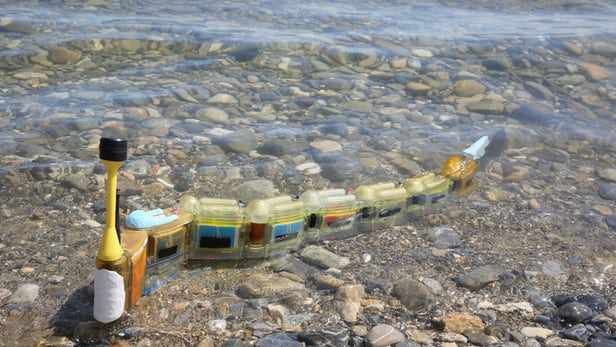Pinpointing Sources of Water Pollution with a Robotic Eel
Published on by Water Network Research, Official research team of The Water Network in Technology
Researchers from EPFL, together with other institutes, have developed a robotic eel that swims through contaminated water to find the source of the pollution.
The sensor-equipped robot can be controlled remotely or move on its own. In tests carried out in a small section of Lake Geneva, the robot was able to generate maps of water conductivity and temperature.

Envirobot can be controlled remotely or swim on its own (Credit: EPFL)
EPFL researchers are taking part in an ambitious project funded by the Swiss NanoTera Program to develop a swimming robot that can detect the source of water pollution. The robot, named Envirobot, is equipped with chemical, physical and biological sensors and measures nearly 1.5 meters long. It moves through water like an eel, without stirring up mud or disturbing aquatic life. Its sensors take measurements at different locations in the water as it swims and send the data to a computer in real-time.
The robot is regularly tested in Lake Geneva. A recent test involved simulating water pollution by diffusing salt into a small area just off the shore, thus changing the water’s conductivity. The researchers then let the robot swim in the contaminated area. The robot successfully mapped the variations in conductivity and generated a temperature map. The ultimate goal is for the robot to be able to detect heavy metals like mercury or other pollutants.
“There are many advantages to using swimming robots. They can take measurements and send us data in real-time – much faster than if we had measurement stations set up around the lake. And compared with conventional propeller-driven underwater robots, they are less likely to get stuck in algae or branches as they move around. What’s more, they produce less of a wake, so they don’t disperse pollutants as much,” says Auke Ijspeert, Head of EPFL's Biorobotics Laboratory (BioRob).
“The Envirobot can follow a preprogrammed path, and has also the potential to make its own decisions and independently track down the source of pollution.” That could be by, for example, steadily swimming in the direction of increasing toxicity.
Sensors comprised of bacteria, crustaceans and fish cells
The robot is made up of numerous modules that each contain a small electric motor for changing curvature, enabling it to move smoothly through the water. The modular design also allows engineers to change its composition and vary its length as needed. “The robot can be easily taken apart, transported to a remote water reservoir, for example, and put back together to begin testing,” says Behzad Bayat, another BioRob researcher.
Some of the modules contain conductivity and temperature sensors, while others have tiny, sophisticated chambers that fill up with water as the robot swims. These chambers contain miniaturized biological sensors that house either bacteria, small crustaceans or fish cells.
The sensors work by observing how these organisms react when put into contact with the water – thereby giving an indication of whether certain key pollutants are present and of the water toxicity in general. The sensors have already proven highly effective in laboratory experiments.
Read more: EPFL
Attached link
http://www.youtube.com/embed/lcsZxJiy5CgMedia
Taxonomy
- Treatment
- Technology
- Monitors
- Contaminant Removal
- Water Quality
- Water Monitoring
- Pollution
- Water Monitoring
- Contaminant Movement Mapping